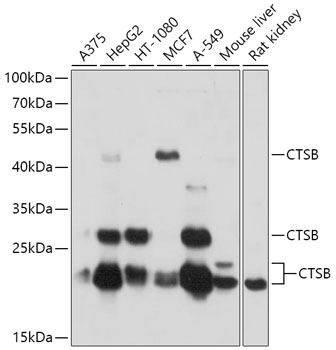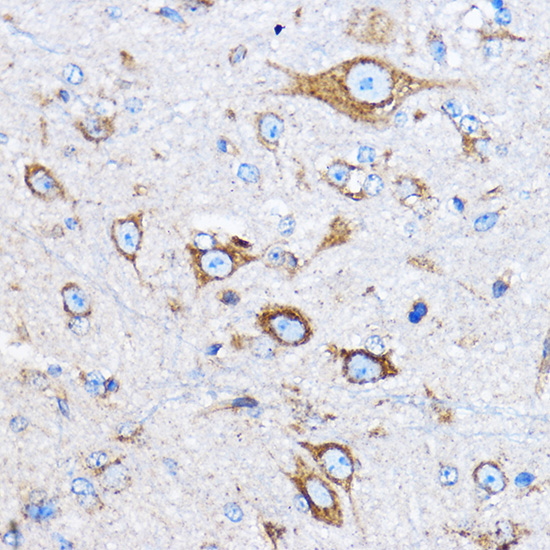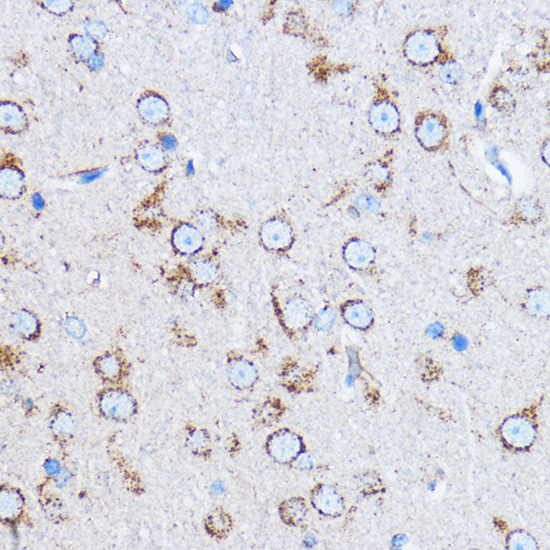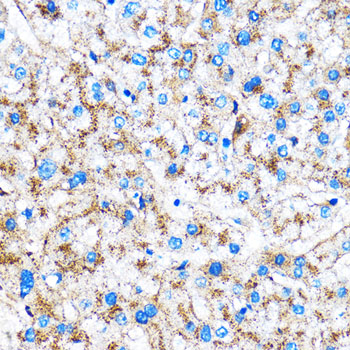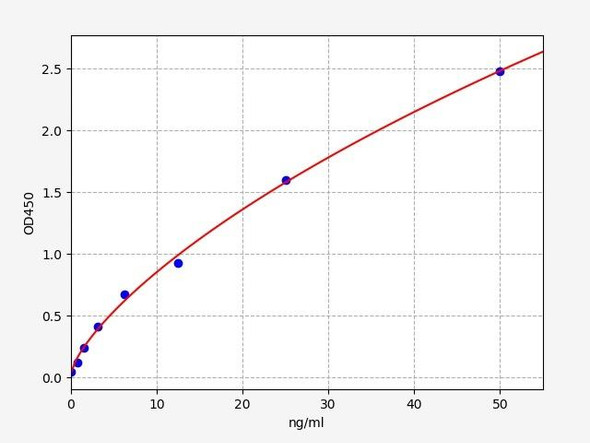Cell Biology Antibodies 1
Anti-CTSB Antibody (CAB0967)
- SKU:
- CAB0967
- Product Type:
- Antibody
- Reactivity:
- Human
- Reactivity:
- Mouse
- Reactivity:
- Rat
- Host Species:
- Rabbit
- Isotype:
- IgG
- Antibody Type:
- Polyclonal Antibody
- Research Area:
- Cell Biology
Description
| Antibody Name: | Anti-CTSB Antibody |
| Antibody SKU: | CAB0967 |
| Antibody Size: | 20uL, 50uL, 100uL |
| Application: | WB IHC |
| Reactivity: | Human, Mouse, Rat |
| Host Species: | Rabbit |
| Immunogen: | Recombinant fusion protein containing a sequence corresponding to amino acids 1-339 of human CTSB (NP_001899.1). |
| Application: | WB IHC |
| Recommended Dilution: | WB 1:500 - 1:2000 IHC 1:50 - 1:200 |
| Reactivity: | Human, Mouse, Rat |
| Positive Samples: | A375, HepG2, HT-1080, MCF7, A-549, Mouse liver, Rat kidney |
| Immunogen: | Recombinant fusion protein containing a sequence corresponding to amino acids 1-339 of human CTSB (NP_001899.1). |
| Purification Method: | Affinity purification |
| Storage Buffer: | Store at -20'C. Avoid freeze / thaw cycles. Buffer: PBS with 0.02% sodium azide, 50% glycerol, pH7.3. |
| Isotype: | IgG |
| Sequence: | MWQL WASL CCLL VLAN ARSR PSFH PLSD ELVN YVNK RNTT WQAG HNFY NVDM SYLK RLCG TFLG GPKP PQRV MFTE DLKL PASF DARE QWPQ CPTI KEIR DQGS CGSC WAFG AVEA ISDR ICIH TNAH VSVE VSAE DLLT CCGS MCGD GCNG GYPA EAWN FWTR KGLV SGGL YESH VGCR PYSI PPCE HHVN GSRP PCTG EGDT PKCS KICE PGYS PTYK QDKH YGYN SYSV SNSE KDIM AEIY KNGP VEGA FSVY SDFL LYKS GVYQ HVTG EMMG GHAI RILG WGVE NGTP YWLV ANSW NTDW GDNG FFKI LRGQ DHCG IESE VVAG IPRT DQYW EKI |
| Gene ID: | 1508 |
| Uniprot: | P07858 |
| Cellular Location: | Lysosome, Melanosome, Secreted, extracellular space |
| Calculated MW: | 37kDa |
| Observed MW: | 24kDa/27kDa/44kDa |
| Synonyms: | APPS, CPSB, Cathepsin B, CTSB |
| Background: | This gene encodes a member of the C1 family of peptidases. Alternative splicing of this gene results in multiple transcript variants. At least one of these variants encodes a preproprotein that is proteolytically processed to generate multiple protein products. These products include the cathepsin B light and heavy chains, which can dimerize to form the double chain form of the enzyme. This enzyme is a lysosomal cysteine protease with both endopeptidase and exopeptidase activity that may play a role in protein turnover. It is also known as amyloid precursor protein secretase and is involved in the proteolytic processing of amyloid precursor protein (APP). Incomplete proteolytic processing of APP has been suggested to be a causative factor in Alzheimer's disease, the most common cause of dementia. Overexpression of the encoded protein has been associated with esophageal adenocarcinoma and other tumors. Multiple pseudogenes of this gene have been identified. |
| UniProt Protein Function: | CTSB: Thiol protease which is believed to participate in intracellular degradation and turnover of proteins. Has also been implicated in tumor invasion and metastasis. Dimer of a heavy chain and a light chain cross-linked by a disulfide bond. Interacts with SRPX2. Belongs to the peptidase C1 family. |
| UniProt Protein Details: | Protein type:Motility/polarity/chemotaxis; Protease; Autophagy; EC 3.4.22.1 Chromosomal Location of Human Ortholog: 8p22 Cellular Component: apical plasma membrane; caveola; external side of plasma membrane; extracellular region; extracellular space; intracellular; intracellular membrane-bound organelle; lysosome; melanosome; mitochondrion; nucleolus; perinuclear region of cytoplasm; sarcolemma Molecular Function:collagen binding; cysteine-type endopeptidase activity; cysteine-type peptidase activity; kininogen binding; peptidase activity; peptide binding; protein binding; protein self-association; proteoglycan binding Biological Process: autophagy; collagen catabolic process; decidualization; entry of virus into host cell; epithelial cell differentiation; extracellular matrix disassembly; extracellular matrix organization and biogenesis; innate immune response; proteolysis; proteolysis involved in cellular protein catabolic process; regulation of apoptosis; regulation of catalytic activity; response to amine stimulus; response to ethanol; response to glucose stimulus; response to organic cyclic substance; response to peptide hormone stimulus; response to wounding; skeletal muscle development; spermatogenesis; toll-like receptor signaling pathway |
| NCBI Summary: | This gene encodes a member of the C1 family of peptidases. Alternative splicing of this gene results in multiple transcript variants. At least one of these variants encodes a preproprotein that is proteolytically processed to generate multiple protein products. These products include the cathepsin B light and heavy chains, which can dimerize to form the double chain form of the enzyme. This enzyme is a lysosomal cysteine protease with both endopeptidase and exopeptidase activity that may play a role in protein turnover. It is also known as amyloid precursor protein secretase and is involved in the proteolytic processing of amyloid precursor protein (APP). Incomplete proteolytic processing of APP has been suggested to be a causative factor in Alzheimer's disease, the most common cause of dementia. Overexpression of the encoded protein has been associated with esophageal adenocarcinoma and other tumors. Multiple pseudogenes of this gene have been identified. [provided by RefSeq, Nov 2015] |
| UniProt Code: | P07858 |
| NCBI GenInfo Identifier: | 68067549 |
| NCBI Gene ID: | 1508 |
| NCBI Accession: | P07858.3 |
| UniProt Secondary Accession: | P07858,Q503A6, Q96D87, B3KQR5, B3KRR5, |
| UniProt Related Accession: | P07858 |
| Molecular Weight: | 37,822 Da |
| NCBI Full Name: | Cathepsin B |
| NCBI Synonym Full Names: | cathepsin B |
| NCBI Official Symbol: | CTSB |
| NCBI Official Synonym Symbols: | APPS; CPSB |
| NCBI Protein Information: | cathepsin B |
| UniProt Protein Name: | Cathepsin B |
| UniProt Synonym Protein Names: | APP secretase; APPS |
| Protein Family: | Cathepsin |
| UniProt Gene Name: | CTSB |
| UniProt Entry Name: | CATB_HUMAN |


